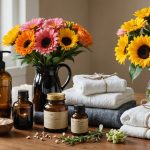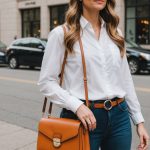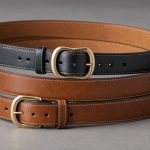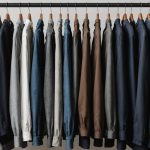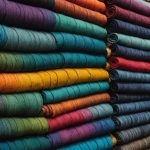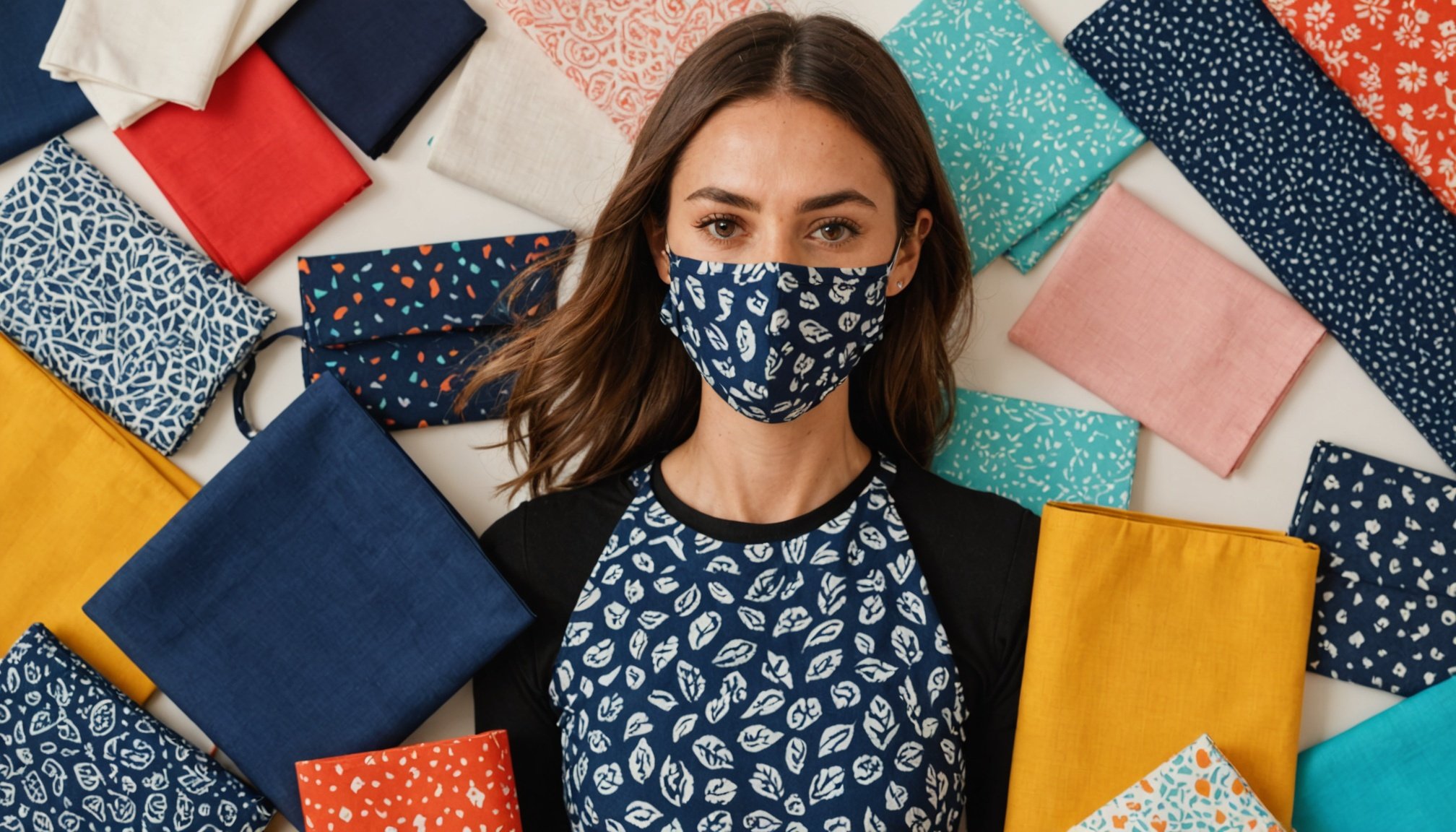Understanding Fabric Types for Face Masks
Choosing the right fabric types for face masks is crucial for both breathability and comfort. Several options are available, each offering unique properties suited for mask-making. When selecting a fabric, prioritise breathable materials like cotton and linen, which are known for their air permeability and comfort.
Cotton remains a popular choice due to its comfortable fabrics and softness, allowing for extended wear without irritation. It effectively balances filtration and ease of breathing, making it ideal for daily use. Linen, another excellent option, offers similar breathability with added durability, ensuring longevity.
Topic to read : Unlock the Secrets to Optimal Hydration: Mastering the Art of Skincare Product Layering for Ultimate Effectiveness!
Consider also fabric blends, where synthetic fibres like polyester are mixed with natural ones to enhance elasticity and fit. These blends often improve the mask’s overall function by providing a snug fit while maintaining comfort, which is especially beneficial in active settings.
Breathability and comfort should always remain primary considerations in fabric selection, ensuring that masks do not obstruct airflow while being worn for prolonged periods. Prioritising these aspects leads to a more positive user experience, encouraging regular mask use. Choosing the right materials not only improves effectiveness but also supports regular and sustained protection.
Also read : Elevate your daytime style: inspiring silk kimono outfits for trendy london adventures
Choosing Colors and Patterns for Personal Style
Selecting fabric colors and mask patterns that match your personal style has become a delightful part of accessorising. With face masks becoming a staple in our wardrobes, fashion enthusiasts are exploring vibrant color trends to stay both safe and stylish.
Currently, bold and bright colors are in vogue, with people gravitating towards shades that bring a pop of joy to their ensembles. Neutrals remain popular too, as they offer versatility and ease in pairing with various outfits.
When choosing patterns, consider designs that reflect current fashion styles. For instance, florals and geometric shapes provide a balance of modernity and elegance. These stylish designs can complement a range of attires, from casual jeans to formal wear.
To ensure your mask complements your wardrobe, think about the colors and patterns prevalent in your clothing. If your closet is filled with subdued tones, a mask with a bold pattern can provide an exciting contrast. Conversely, a simpler design can subtly enhance a more vibrant outfit.
Ultimately, selecting a mask color and pattern that resonates with your personal style allows you to express yourself, even while adhering to health guidelines. Stay safe, and let your mask be a reflection of your unique fashion sensibilities.
Texture and Weight Considerations
Understanding the fabric texture of a mask is crucial to both its aesthetic appeal and practicality. Texture influences how a mask feels against your skin and how it looks when you wear it. A smoother fabric offers a sleek appearance, while textured materials like woven fabrics add an element of depth. The texture can also affect breathability, influencing overall comfort during extended use.
The weight of the fabric plays a significant role in a mask’s functionality and comfort. Heavier fabrics typically provide better protection but may compromise breathability. Lighter fabrics are often more breathable but might not filter particles as effectively. Striking a balance ensures that the mask is not only safe but also comfortable for everyday wear.
A key tip for balancing style and practicality is to consider fabric drape. This refers to how easily the fabric falls or hangs. A well-draped mask maintains its shape and enhances comfort. Choose fabrics that offer the right balance of weight and drape for a mask that looks good and feels right. Prioritising these elements allows for an aesthetically pleasing mask that doesn’t sacrifice on safety or comfort.
DIY Face Mask Design Ideas
Discovering exciting DIY mask projects can be a delightful way to combine creativity and practicality. Your personal touch can turn a mask into a statement piece with unique sewing patterns.
Simple sewing techniques for beginners
If you’re new to sewing, start with straightforward designs that use basic materials. Using a simple pattern with cotton fabric is ideal due to its breathability and ease of use. Focus on mastering straight stitches and attaching elastic bands for a secure fit. This approach ensures beginners create a functional and stylish mask without difficulty.
Advanced designs with unique fabric combinations
More experienced crafters can experiment with combining fabrics. Mixing different textures like cotton or silk offers customized designs and improved comfort. This technique allows you to express your style while maintaining the mask’s functionality, giving even an everyday mask a unique twist.
Using embellishments to enhance style
Adding embellishments can elevate your design. Consider sequins, beads, or embroidery to create a mask that stands out. When applying these, ensure they don’t compromise breathability or comfort, especially around the nose and mouth area. Such additions can create an eye-catching piece that reflects your personality.
In essence, whether you’re a novice or a seasoned DIYer, tailoring your mask aligns function with individual flair.
Sourcing Fabrics and Tools for Your Project
When embarking on a DIY mask-making journey, selecting the right fabric sources and purchasing fabric are crucial steps. A great start is to explore a mix of online and local fabric suppliers, renowned for their variety and quality. Many crafters recommend reputable online platforms like Spoonflower and Fabric.com for their vast collections. Locally, you may find quality selections at speciality quilting shops or fabric stores like Jo-Ann Fabrics, always a favourite for its diverse inventory.
Equally important are the essential DIY tools required for crafting masks efficiently. At a minimum, you will need:
- Scissors or rotary cutters,
- Sewing machines or needles and thread for hand stitching,
- Flexible measuring tapes,
- Pins or fabric clips to hold fabric in place,
- Iron for pressing seams, improving the mask’s comfort.
Shopping for tools online can be user-friendly, giving you access to specialised sewing kits that include everything from cutting mats to thread assortments. By procuring quality fabrics and equipping yourself with the right tools, the craft of mask-making becomes not only enjoyable but also allows for the creation of protective and stylish masks.
Visual Examples of Stylish DIY Masks
Exploring stylish mask examples can inspire creativity and innovation in your personal projects. Many DIY enthusiasts craft unique masks that not only serve as protective gear but also act as personal fashion statements. Here, we delve into artistic fabric masks designed by talented individuals, highlighting the choices making each mask stand out.
Design elements play a crucial role in transforming a simple mask into a stylish accessory. From intricate patterns to vibrant colours, the possibilities are endless. For instance, floral prints and geometric shapes are popular, providing an elegant yet modern touch. Incorporating adjustable straps and breathable fabrics further enhances functionality without compromising style.
Sharing your creative outputs can foster a sense of community and provide design inspiration for others. By showcasing your designs on social platforms or dedicated mask-making groups, you contribute to a collective pool of ideas. Witnessing diverse mask examples can help fellow DIYers explore new techniques and colour combinations.
Encouraging collaboration and the exchange of ideas not only improves people’s creations but also fosters a supportive network of crafters. Whether you’re a novice or an experienced designer, engaging in such communities can open the door to endless inspiration and innovation.
Choosing the Right Fabrics for DIY Face Masks
Selecting the right fabric types for face masks is essential in ensuring both protection and comfort. The fabric you choose significantly impacts how breathable and effective your mask will be.
When considering breathable materials, cotton emerges as a top choice. Its natural fibres are known for their softness and ability to allow airflow, making it comfortable for extended wear. Linen is another excellent option; although slightly less soft than cotton, it is incredibly breathable and naturally antibacterial. Conversely, polyester might not be your first choice if breathability is your primary concern. While it is durable and resistant to shrinking, it doesn’t allow as much airflow, potentially causing discomfort over time.
Key considerations
- Cotton: Offers a balance of protection and comfort. Widely available and versatile.
- Linen: Extremely breathable and antibacterial but might require a blend with other fabrics for durability.
- Polyester: Less breathable but adds durability. Best used in combination with more breathable fabrics.
Understanding these differences can help you choose the best cloth mask fabrics for your needs, ensuring that you create a mask that is both protective and comfortable to wear.
Color Coordination for Stylish Masks
When it comes to coordinating masks with your outfits, color theory can be a game changer in achieving a put-together look. Understanding the basics of color matching is crucial for seamless style integration. By choosing shades that complement your wardrobe, you enhance both the mask’s visual appeal and your overall ensemble.
To start, consider your existing wardrobe palette. Are your clothes predominantly warm-toned or cool-toned? Selecting masks in the same tone can create a cohesive look. For those who enjoy bold fashion choices, contrast can be effective—pair a vibrant mask with neutral clothing or vice versa for a striking effect.
Stylish mask design also plays a substantial role. Many masks now come with intricate patterns and multiple colors, allowing flexibility in coordinating with diverse outfits. An insight: if an outfit features busy patterns, a solid-colored mask might offer balance.
Here’s how to integrate color coordination effectively:
- Choose a primary color in your outfit and match it with your mask.
- Use complementary colors (e.g., red and green) for a vibrant yet harmonious look.
- Neutral masks like black, white, or grey can effortlessly blend with any attire.
With these tips, creating a stylish, cohesive appearance with your mask becomes straightforward.
Patterns and Prints for Unique Mask Designs
Adding a touch of flair to your face mask has become a delightful trend, seen in the rise of patterns for face masks. Options range from classic floral motifs to contemporary geometric designs, allowing individuals to express their personalities and style preferences effortlessly. Trendy prints provide not only protection but also a fun way to accessorise.
To make your mask truly stand out, consider incorporating mask customization. This involves selecting specific elements like colours or symbols that resonate with you personally. Some might choose to add initials or emblems of favourite bands, while others might opt for prints celebrating cultural motifs.
Expressing personal style through your mask is a statement that goes beyond mere aesthetics. It reflects your lifestyle, interests, and even your mood. For instance, those who prefer bold and daring fashion might select masks with neon colours or striking abstract art.
Moreover, custom designs can lend a sense of individuality in a world where conformity often prevails. These design choices not only highlight creativity but also allow for a more cohesive look with existing wardrobe choices, making masks a seamless and stylish part of everyday attire.
Practical Tips for Mask Construction
Creating a mask involves more than just cutting fabric. Understanding essential sewing techniques is vital for crafting durable and effective masks. First, use a tight stitching pattern, like a straight or zig-zag stitch, to ensure the seams are secure. Overlapping stitches at the edges can also strengthen the structure.
When selecting a design, opt for popular face mask patterns such as pleated or fitted styles. These templates often include guides for cutting and stitching. DIY mask construction becomes simpler when you have a reliable pattern as a starting point.
Adjusting the fit is crucial for both comfort and efficacy. A well-fitted mask should cover the nose and mouth without gaps at the edges. To achieve this, consider using adjustable ear loops or adding a nose wire to conform to facial contours. Elastic bands with adjustable toggles contribute to a customised fit, enhancing both comfort and protection.
These mask sewing tips ensure you can create a mask that not only provides protection but is comfortable for prolonged wear. Remember, the goal is to craft a mask that is both functional and easy to use, empowering you to navigate daily tasks confidently.
Recommended Fabric Sources
When embarking on face mask creation, choosing the right materials is crucial. There are two main avenues to explore: fabric stores for face masks and online fabric shopping. Both offer unique benefits. Local stores allow you to physically feel the fabric, ensuring it meets your standards for breathability and comfort. However, the convenience of online shopping offers an extensive range of patterns and materials at your fingertips.
Opting for ethical fabric sourcing is an important consideration. Ensure that the materials you select are produced with minimal environmental impact and fair labour practices. Look for certifications that guarantee fabrics are sustainably produced and workers are fairly treated. This not only supports ethical practices but also appeals to environmentally-conscious customers.
For sourcing, several popular suppliers specialise in fabrics optimal for mask-making. Online platforms like Etsy and Spoonflower offer unique, often handmade or small-batch options. For customers prioritising sustainability, shops like Organic Cotton Plus and Fabric.com feature ethical fabric sourcing options. Each supplier presents a wide assortment of colours and textures, catering to the diverse needs of face mask crafting.
With thoughtful selection, you can find the perfect fabrics to create comfortable and environmentally-friendly masks.


